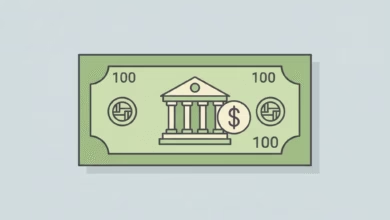
Secured loans, often touted as a flexible financial solution, involve using an asset you own as collateral. This can range from a car to a property. While they offer distinct advantages, the question remains: “Is it worth leaving a valuable asset on the line for a loan?” This article will break down everything you need to know, helping you make an informed decision for your financial well-being.
What is a Secured Loan? Understanding Collateralized Borrowing

At its core, a secured loan is a type of debt where the borrower pledges an asset as security. This asset, known as collateral, reduces the risk for the lender. If the borrower defaults on the loan, the lender has the right to seize and sell the collateral to recover their losses. Common examples of1 secured loans include mortgages (where the property is collateral) and auto loans (where the car is collateral). Personal secured loans can also use assets like investment portfolios, jewelry, or even future income streams as collateral.
Advantages of Secured Loans: Unlocking Lower Rates and Higher Limits
The primary benefit of a secured loan lies in its lower risk profile for lenders. This reduced risk often translates into several advantages for the borrower:
- Lower Interest Rates: Because the lender has an asset to fall back on, they typically offer significantly lower interest rates compared to unsecured loans. This can lead to substantial savings over the life of the loan.
- Higher Borrowing Limits: Lenders are often willing to lend larger sums when collateral is involved, as their exposure is minimized. This can be beneficial for significant expenses like home renovations, business investments, or debt consolidation.
- Easier Approval: Individuals with less-than-perfect credit scores may find it easier to qualify for a secured loan, as the collateral mitigates some of the credit risk.
- Flexible Repayment Terms: Some secured loans offer more flexible repayment schedules, allowing borrowers to tailor payments to their financial capacity.
Disadvantages of Secured Loans: The Risks of Pledging Your Assets

While the benefits are appealing, it’s crucial to acknowledge the potential downsides of secured loans:
- Risk of Losing Your Asset: This is the most significant disadvantage. If you fail to make your payments, you stand to lose the asset you pledged as collateral. This could be your home, your car, or another valuable possession.
- Asset Depreciation: The value of your collateral might decrease over time. If the value of your asset falls below the outstanding loan amount, you might face a “negative equity” situation.
- Foreclosure or Repossession Costs: If the lender has to seize your asset, you may also be responsible for additional fees associated with the foreclosure or repossession process.
- Less Financial Flexibility: With your asset tied up as collateral, you might have less financial flexibility for other opportunities or emergencies.
When Does a Secured Loan Make Sense? Strategic Financial Planning
A secured loan can be a smart financial move in specific situations:
- Consolidating High-Interest Debt: If you have multiple high-interest debts, a secured loan with a lower interest rate can help you consolidate them into a single, more manageable payment, potentially saving you a lot of money.
- Funding Major Investments: For significant investments like a down payment on a second property, a large business expansion, or education, a secured loan can provide the necessary capital at a favorable rate.
- Improving Your Credit Score (Responsibly): If managed responsibly with on-time payments, a secured loan can help improve your credit score over time, opening doors to better financial products in the future.
- Emergency Funding (as a Last Resort): In dire financial emergencies, when other options are unavailable, a secured loan can provide quick access to funds, but this should be approached with extreme caution due to the asset risk.
How to Choose the Right Secured Loan Lender: Key Factors to Consider

Selecting the right lender is crucial for a positive secured loan experience. Here’s what to look for:
- Interest Rates and APR: Compare interest rates and the Annual Percentage Rate (APR) from various lenders. The APR includes all fees and charges, giving you a more accurate picture of the total cost.
- Loan Terms and Repayment Flexibility: Understand the loan duration, repayment schedule, and any prepayment penalties.
- Fees and Charges: Be aware of origination fees, appraisal fees, late payment fees, and any other hidden costs.
- Lender Reputation and Customer Service: Research the lender’s reputation, read reviews, and assess their customer service. A reputable lender will be transparent and responsive.
- Collateral Requirements: Ensure your asset meets the lender’s collateral requirements and that you understand the valuation process.
Maximizing Your Secured Loan Benefits: Best Practices for Borrowers
To make the most of your secured loan and minimize risks:
- Borrow Only What You Need: Avoid borrowing more than absolutely necessary. The less you borrow, the less interest you pay and the sooner you can repay the loan.
- Create a Realistic Repayment Plan: Before committing, develop a clear and realistic plan for how you will make your payments on time, every time.
- Understand the Fine Print: Thoroughly read and understand all terms and conditions of the loan agreement, especially those related to collateral and default.
- Maintain Your Collateral: Keep your collateral in good condition, as its value can impact your loan terms and your financial standing with the lender.
- Consider Insurance: Depending on the asset, consider insuring it to protect its value, which indirectly protects your financial position.
Alternatives to Secured Loans: Exploring Unsecured Options
Before opting for a secured loan, explore other financing options that might be a better fit for your situation:
- Personal Unsecured Loans: These loans don’t require collateral but typically come with higher interest rates and stricter credit requirements.
- Credit Cards: Useful for smaller, short-term expenses, but their high interest rates make them unsuitable for large or long-term borrowing.
- Lines of Credit: Offer flexible access to funds up to a certain limit, often with variable interest rates.
- Borrowing from Friends or Family: A potentially interest-free option, but it can strain personal relationships if not managed carefully.
- Selling an Asset: If you have an asset you no longer need, selling it might provide the funds you require without incurring debt.
The Future of Secured Lending: Trends and Innovations

The secured lending landscape is continuously evolving. We are seeing trends towards:
- Digitalization: More online platforms are offering secured loans, making the application process faster and more convenient.
- Diversification of Collateral: Lenders are becoming more open to accepting a wider range of assets as collateral, beyond traditional real estate and vehicles.
- Personalized Loan Products: Lenders are increasingly using data analytics to offer highly personalized secured loan products tailored to individual borrower profiles and assets.
- Focus on Financial Education: A growing emphasis on educating borrowers about the risks and benefits of secured loans to promote responsible lending and borrowing.
Final Verdict: Is a Secured Loan Right for Your Financial Goals?
Deciding whether to use an asset for a secured loan requires careful consideration of your financial situation, risk tolerance, and long-term goals. While secured loans offer attractive interest rates and higher borrowing limits, the inherent risk of losing your collateral demands a disciplined approach to repayment. If you have a stable income, a clear repayment plan, and a compelling reason for the funds, a secured loan can be a powerful tool to achieve your financial objectives. However, if there’s any doubt about your ability to repay, exploring unsecured options or alternative solutions might be a safer path. Always consult with a financial advisor to determine the best course of action for your unique circumstances.





